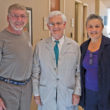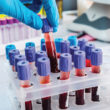Important New Study Shows PSA Test Cuts Prostate Cancer Death Rate by Half

In the journey to discover the best diagnostic and treatment methods modern medicine can provide, researchers conduct long-term studies on existing screening practices.
The outcomes can clarify practices but also they can confuse and sometimes even mislead the public.
Recent media coverage from two long-term studies (*ERSPC and **PLCO) on PSA testing and regular screenings unfortunately caused a quandary of concerns and questions.
Now, a new landmark, long-term population-based study (***Goteborg) from Sweden helps clear up many of the questions regarding prostate cancer screening created by the previous two studies.
It found the PSA test reduces prostate cancer death rate by half (44% in men randomized to be invited for screening and by 56% in those who were actually screened).
Findings Encourage PSA Testing
The findings should encourage men to have annual PSA tests and should encourage physicians to recommend regular screenings.
Dr. Jonas Hugosson, from the University of Gothenburg, Sweden, and his colleagues undertook the trial to assess the merits of screening men for PSA.
Overall, the findings show lifesaving benefits derived from PSA screening – ones comparable to or better than breast cancer and colorectal cancer screening – and they found “the risk of overdiagnosis is far less than previously reported.”
This study is the most informative clinical trial of population-based screening performed to date.
Prostate cancer is a leading cause of death from cancer in the Western world, and this study confirms that one way of decreasing the death rate from the disease is through screening with the prostate specific antigen (PSA) blood test.
“Study shows PSA test reduces prostate cancer
death rate by at least 44 percent.”
Answering Two Important Questions
Prostate cancer is an insidious disease that arises silently, passes through a curable phase silently, and becomes incurable silently. If you wait for symptoms to signal its presence, it is too late to cure it.
The Swedish study provides important information for two areas of recent concern:
1. What are the lifesaving benefits of PSA screening in relation to the numbers needed to screen and treat for preventing 1 prostate cancer death?
2. Knowing the statistics, are men ready and willing to participate in the diagnostic practices used for early detection of prostate cancer?
This study, which is still ongoing, randomized men between the ages of 50 and 65 years to either a screening or control group. Each group had almost 10,000 men. When men in the screening group were found to have an increased PSA, they were offered additional tests such as digital rectal examination and prostate biopsy.
Overall, to prevent one prostate cancer death, 293 men were screened and 12 diagnosed.
The Goteborg study concluded: “The benefit of prostate-cancer screening compares favourably to other cancer screening programs.”

Most important, over the 14 years of follow-up, prostate cancer deaths decreased almost by half in the screening group compared with men in the control group.
Also, diagnosis of advanced prostate cancer in the control group was double that of the screened group.
These differences in cancer stage at diagnosis affected treatment practices: More hormonal therapy – a treatment to slow the progression of cancer but not provide a cure – was used in the control group; whereas, surveillance or treatment with intent to cure was used more often in the screened group.
“Findings should encourage men to have annual PSA test.”
Wanting to Know
“It feels ethically difficult not at least to inform all men over the age of 50 about PSA and its possibilities. Personally, I would recommend my friends check their PSA.” Dr. Jonas Hugosson, lead author Goteborg Study
Because cancer screenings in general involve the testing of many people to find relatively few cancers – which is a fact for which we should be grateful – some have questioned the psychological effect of participating in screenings.
This study found that men were quite willing to participate in prostate cancer screenings.
The vast majority of those invited to be in the screening group accepted and followed through on all the recommendations from the screening results.
The participation statistics for the screening group show, according to the report:
“The screening procedures with PSA testing and prostate biopsy were seldom associated with severe psychological distress, even for men with repeatedly raised PSA concentrations. We therefore conclude that acceptance is not an obstacle for a populationbased prostate cancer screening program.”
The risk of over-diagnosis is present but that is true for all cancers detected through screening practices. The PSA test, with its refined variations, is still the best method of prostate cancer detection we have.
Clearly, we need to keep looking for markers that better identify men with intermediate and high-risk prostate cancers, but also we have to use the best information we have now to save as many lives as we can.
Reliability of Study

The Goteborg study shows a much higher lifesaving effect for PSA testing than in the two previous studies that received so much media attention. In the Goteborg report, researchers list several reasons why their figures are different from the ERSPC and PLCO studies and more reliable.
First, the men in their study were younger than men in previous studies. The median age for the baseline screening was 56. As their report states, “Younger men are less likely than older men to have incurable prostate cancer at the first screening and therefore more likely to gain the full benefit of screening.”
The URF appreciates and needs your support for its lifesaving mission to support research and patient education in prostate cancer. Please consider a generous donation.
Second, the PSA threshold for biopsy was lower in their Goteborg study (2.5 to 3 ng/ml) than in the ERSPC study and in the PLCO trial so the screenings detected the cancer sooner. Digital rectal exams (DRE’s) were not part of the Goteborg screening, but if DRE’s had been, an even larger lifesaving effect might have been found as a result of screening.
In addition, this study had a much higher rate of biopsy for men with a positive screening result and a much lower rate of PSA testing before the start of the study. In most of Sweden, screening for prostate cancer does not occur outside of clinical trials. The estimate was that 3% of the group had a previous PSA test; whereas, in the PLCO studies, it was 44%.

The Goteborg control group was, in fact, a true control group. The rate of contamination in the US PLCO control group affected the results because PSA screening is a common practice in the US. In fact, one could question whether there really was an effective control group in the PLCO trial.
Follow up time was longer in the Goteborg study: a median of 14 years. For up to 10 years, the findings were similar to those in the ERSPC study. The findings indicate that most of the benefit from screening occurs after 10 years.
The significant conclusion reported by this study is: “Prostate cancer screening was well accepted by the general population and can result in a relevant reduction in cancer mortality, greater than that reported in screening for breast or colorectal cancer.”
* ERSPC: European Randomized Study of Screening for Prostate Cancer
**PLCO: US Prostate, Lung, Colorectal, and Ovarian Cancer Screening Trial
***The full Goteborg article (Mortality results from the Goteborg randomized population-based prostate-cancer screening trial) is available on-line: http://press.thelancet.com/tloprostmort.pdf
*ERSPC and **PLCO











